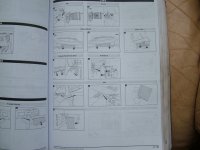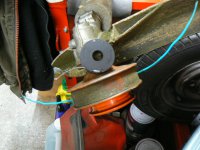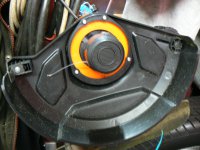Hi there Puggit Auld Jock and thanks for your summary.
I'm using a service schedule from "Fiat Workshop" which gives a number of things to do, many of which I missed at 72,000 miles so I'm catching up. I've attached a scan, which shows what I'm following as a guide.
Spark plugs? The Auto Data Manual gives NGK ZKR7A-10, which I will follow. and yes, a new rocker cover gasket.
Tell me what a VVT engine is, please! My engine's code is 350A1.000. Difficult to tell over the phone if the person advising me had dirty finger nails but next time I will ask! I take your point and more than one garage has sounded vague on the subject of tappets. One has included 8 cam followers on the parts list. Is this right?
I have a go at many maintenance jobs but, given that timing and the cam belt is so cemtral to things, I think paying for a trained trade person is probably a good investment for me.
Hope the rain held off for the mowing.
Hi again. The rain did indeed hold off and I got the grass mowed, a couple of plants moved, My shaped bush got a quick hair cut and all the tubs and hanging basket got a good soaking.
Now sitting with a cup of tea and Mrs J has come up with a cherry scone! Hoping EVRi are about to deliver the bits I need to repair my neighbour's strimmer and browsing through my Haynes Punto Manual while I wait - Haynes publication 5956 - Like all the modern Haynes manuals it's not the be all and end all when it comes to manuals, but it does contain a lot of very handy info and I can recommend getting one - I'm sure a used one off ebay would be fine.
The NGK ZKR7A-10 are the "normal" plugs which I use. They are not long life and I replace them every 2 years and whip them out for a quick gap check after a year. I like to keep my gaps within spec to reduce the load on the coils if the gaps get wide. Actually I think they'd probably go on for longer but they're not a lot of money so I do them biannually. I believe the NGK long life plugs are ZKR7A1-8 But I've never felt the need to go for them as the standard jobbies do just fine for me. (and the long life ones are considerably more pricey) By the way, it's not now advised to use a grease on modern plugs any more - typically I'd have used copper grease to reduce the tendency for the plugs to seize/corrode to the head. Modern plugs have a plated finish on the threads, which looks a bit like chrome or nickel but is actually "trivalent" (whatever that is) and is designed to reduce the tendency to seize and, should the threads seize, it's designed to shear away thus releasing the plug. I believe there is an operational advantage too in that the electric current flows more easily without the copa slip thus encouraging a "better" spark. I've been fitting plugs without greasing them for about two, maybe three, years now without any problems and my tin of grease gets used for other stuff.
My Haynes manual shows the 350A1.000 engine as being the single cam 8 valve fitted from 2006 onwards and lists it as a VVT. So, Ok, what's a VVT engine? Variable Valve Technology is what it stands for by the way and what this involves is a camshaft sprocket which is not solidly locked to the camshaft itself! On older engines the camshaft sprocket was a solid component with a key way which lined up with a key way cut in the camshaft and something like a woodruff key (piece of metal) fitting in the slots so locking them together. With a VVT pulley there is no keyway so if you slacken the big bolt/nut holding the pulley onto the end of the camshaft then the pulley can spin freely on the camshaft - and you've just lost the timing! To set it all up again you need a set of cam and crankshaft locking tools (available on the likes of ebay for around 30 to 40 quid.) A non VVT engine will not have that solenoid but often has a cam position sensor on the front end of the cam cover which might be confused for the solenoid if you don't know what you're looking at. My boy's Punto, with VVT, has it's cam sensor on the back end (above the bell housing) of the cam cover.
So what's the big deal with this VVT pulley? Well, the central boss, which the big bolt locks to the camshaft, is free to move (over a limited range of degrees) relative to the toothed outer segment of the pulley assembly. In other words the pulley is actually two parts. Between the inner and outer parts of the pulley there are chambers into which oil from the engine oil supply, can be introduced which either advances or retards the camshaft position in relation to the outer toothed segment of the pulley. Strewth, complicated eh? So why do this? Well, it's complicated, but at it's simplest what's going on is that at low engine speeds springs in the pulley keep the cam in it's retarded position so the cam timing is "mild" and the engine behaves in a docile fashion. As the revs rise the ECU will command the solenoid valve in the cam cover to open (it's just to the left of the oil filler cap. Looks like a wee barrel shaped thing sitting at right angles to the axis of the camshaft on the cam cover with an electric wire going into it) at low revs it shuts off the oil supply to the pulley which means the springs keep the cam retarded so the engine ticks over nicely and pulls well. However, as the revs go up, gas flow will benefit from a more sporty cam configuration and this is partially accomplished by the ECU opening the solenoid and allowing engine oil under pressure, to enter the pulley and act against the springs holding the cam in the retarded position so advancing the cam relative to the pulley teeth and thus making the valve timing more aggressive and allowing the engine to produce a little more power than it would with a fixed pulley. I'm sure there are emission implications too. This wee solenoid valve has a screening filter which is worth checking from time to time for contamination. However I doubt if many ever get checked except by diligent enthusiasts like us.
I'm really scratching my head as to why 8 cam followers, or even 1 cam follower, might be needed unless there's something very wrong with the engine. But without being there and checking it for myself I don't know why this recommendation may have been made, sounds weird to me though.
If you're not happy with doing the belt I think you're very wise to hand it off to a "professional". These engines have been around for years and any competent mechanic should have no bother with it. There's always the possible problem that a Phonic Wheel Relearn may be needed and there's a couple of things of interest regarding this. The recommended way to do the job is to use the locking tool kit to position the crankshaft and camshaft and loosen the camshaft pulley retaining bolt so the pulley can spin freely on the camshaft when the new belt is fitted. After the new belt is fitted and fully tensioned the cam pulley retaining bolt is then tightened up thus ensuring the timing is "spot on". It's very likely the relative position of the camshaft relative to the crankshaft, as perceived by the ECU via the position sensors, will be very slightly different and it's this which causes the ECU to get "upset", light up the engine management light and post a DTC (Diagnostic Trouble Code) which can be read with a scanner -
MES strongly recommended. Doing a Phonic Wheel Relearn "teaches" the new relative positions to the ECU and settles it down again.
Now here's the thing. Many small garages won't have the locking tools, especially if they're not Fiat specialists, so will do the belt by the "tippex" method. I don't recommend this to anyone who is not very confident "playing about" with engine valve timing and thus will know what to do if they completely loose the settings. However, because it interests me, I've played about quite a bit with doing this job both with the correct tools and by the "tippex" method and I can say with confidence, if you do it by the tippex method, the MIL stays out! (or has done for every one I've tried doing this way) Once you slacken that cam pulley bolt, there's a good chance you're going to get the light and need to do a relearn. I'm pretty sure I know exactly what's going on with this but it's too involved to discuss here.
By the way, the trouble code posted when a Phonic Wheel Relearn is needed will often be one for a miss fire - the ECU doesn't seem to be able to recognize that a relearn is required and posts for a misfire instead - People on the forum have reported spending substantial amounts of money replacing stuff like coils, HT leads, etc trying to cure the miss fire when what was actually required was a relearn. The big giveaway is that although the ECU may be flagging up a miss fire there's not evidence of it when driving. So no uneven tickover, no jerking about, in fact none of the "classic" indicators of misfiring.
And, just to finish off for now, I'd recommend cleaning the MAP sensor at every major service, maybe even every year. It's only held in with one screw (to the side of the throttle body) It gets contaminated with oil from the breather system and I find it makes quite a difference to how the engine pulls if you clean it - I clean mine with a dedicated MAF sensor cleaner but I'd think something like brake cleaner would do the job just fine - make sure it's completely dried off before running the engine.
By the way RedPeril, if you do the cabin (pollen) filter, do let me know how you get on. I find the one on my Boy's 2012 car is a bit of a swine to do and has to be "scrunched up" a bit to get it to go in. Seems to go back to it's proper shape once in though.
Still no delivery from EVRi!





